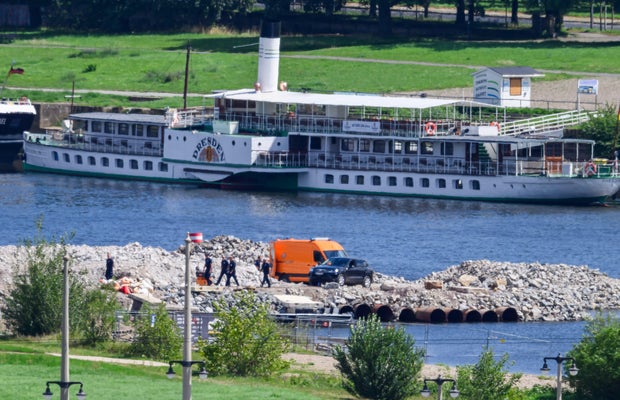Thousands Leave Dresden Core as WWII Relic Is Traced Beneath Rubble
Early Wednesday, a low-flying drone swept across the cobblestones of Dresden’s historic heart, confirming what construction crews had feared: a rust-coated 250 kg aerial bomb remains lodged just metres from where the Carola Bridge once stood. Within minutes the alarm went out.
Evacuation at a glance
- 17,000 residents, tourists, hotel guests, and shopkeepers required to vacate
- Exclusion zone rings the Frauenkirche, the 18th-century domed landmark reborn after 2005
- Trams halted, river traffic paused, and air-space closed for the bomb squad’s day-long window
A city forced to un-seal its wounds
Dresden knows the scars of 1945 all too well. When the bridge’s central span gave way without warning last September, the subsequent clearance exposed the bomb’s tail fin—unexploded since the firestorm nights that levelled the Altstadt. Engineers chose a phased evacuation to give disposal teams room to drill, freeze, and finally cut the fuse late in the afternoon.
Local life disrupted in hours, not days
Kindergarten teachers marched children through quiet streets to reception halls across the river. Café owners on An der Frauenkirche wheeled espresso machines into waiting vans rather than risk vibration damage. Hotel guests formed orderly queues for shuttle buses, clutching coffee vouchers handed out by apologetic concierges.
Unseen legacy below daily footfall
Officials admit that every second construction site in the city risks unearthing similar relics; Saxony alone holds 300–400 annual bomb alerts. With reconstruction of the Carola Bridge now delayed another fortnight, city planners warn the ghosts of the past still shape the tempo of progress.

Historic Carola Bridge Cleared: British 500-pound WWII Bomb Safely Removed in Dresden
Evacuation Area Secured Overnight
Specialist bomb-disposal teams from Explosive Ordnance Disposal Saxony breathed a collective sigh of relief early Wednesday, August 6, 2025, as they walked away from the Carola Bridge worksite in Dresden, Saxony. The team had spent tense hours neutralizing a 250-kilogram RAF device dating from World War II—discovered barely 24 hours earlier while construction crews stripped the aging structure for its slated demolition.
Key Safety Measures Executed Before Detonation
- 1,000-meter exclusion cordon set up at dawn, closing river traffic and surrounding streets
- Transit services rerouted via temporary ferry crossings and detour buses
- Nearby hospitals, schools, and care facilities placed on stand-by; no residential evacuations were required
- River Elbe water level briefly lowered to lessen shock-wave impact should a controlled explosion become necessary
Why WWII Bombs Still Matter Today
8 decades after the guns fell silent, an estimated 2,000 tons of unexploded Allied and German ordnance still rest beneath German soil, riverbeds, and concrete foundations. Experts predict bomb-recovery teams will remain busy for another 50–100 years because:
- Post-war rubble often concealed bombs that missed their targets
- Rapid urban expansion over former industrial and marsh areas regularly re-exposes remnants
- Chemical deterioration now makes fuses increasingly unpredictable
Recent Largest Evacuation: Cologne, June 2025
Just two months ago, Cologne staged its biggest evacuation since 1945.
- 20,000+ residents left a 1.5-kilometer safety zone in city center
- Two 2,000-kg U.S. blockbuster bombs plus one 1,000-kg bomb found during a metro-tunnel probe
- Key landmarks affected: one major hospital, two senior residences, nine schools, and a television studio
Carola Bridge: Next Milestone in October
With the bomb safely defused, deconstruction crews can now accelerate their timeline. Heavy machinery will return within days, clearing decking, cables, and piers ahead of the full October 2025 demolition deadline set by the city council.
Public Advisory
Dresden authorities encourage anyone discovering suspicious metal objects—especially near construction zones—to call the emergency hotline 112 and avoid disturbance until professionals arrive.

Dramatic Dresden Evacuation: 500-Kilogram Relic Forces City to Go Silent
August 6, 2025—Dresden’s historic Altstadt fell eerily quiet before dawn as bomb-sniffer dogs, engineers and police officers ringed the Theaterplatz. Work crews had unearthed an American 500-kg aerial device still wedged with intact fuzes. Within minutes the local warning sirens switched to a high-low pattern, signalling mandatory evacuation for 9,400 residents and office workers.
To keep the city moving, Dresden’s public transport firm DVB rolled out a bright yellow shuttle convoy. Buses looped every six minutes from Theaterplatz to the exhibition grounds in Südvorstadt, while ferries added extra crossings along the Elbe. “We can evacuate several thousand people without leaving anyone stranded,” said DVB spokeswoman Katja Möller as passengers boarded with cats, suitcases and violins.
Global Scrapbook: Other Recent UXO Scares
- Paris, March 2025 – Track-bed engineers near Gare du Nord uncovered a British aircraft bomb; Eurostar services paused for three hours.
- Northern England, February 2025 – 173 small mortar rounds surfaced beneath a newly laid children’s playground; a remote-controlled arm scooped them into sand-filled crates.
- Miyazaki, Japan, October 2024 – A long-buried US naval shell exploded seconds after a taxi passed, leaving a 60-centimetre crater beside the runway.
Why These Relics Still Matter
Experts estimate that at least 100,000 tonnes of unexploded ordnance lie scattered across former European battle zones. Rust never sleeps; corrosion can render the chemical fuzes even more delicate than when first dropped. Dresden alone has defused 47 aerial bombs in the past decade.
By 15:30 local time, robotic shears had snipped the last electrical connector. A dull thud echoed across the river as specialists detonated the device in a sand-lined pit. Trams glided back along the cobblestones, café terraces reopened, and the Elbe once again mirrored Baroque spires rather than flashing blue lights.




